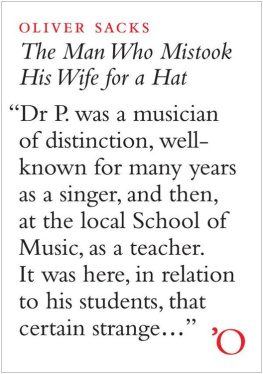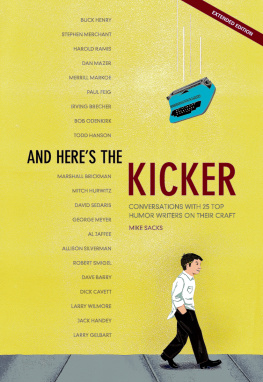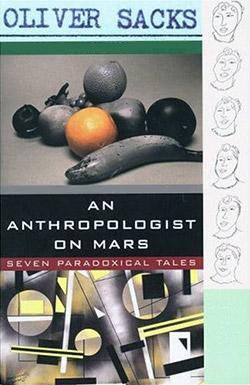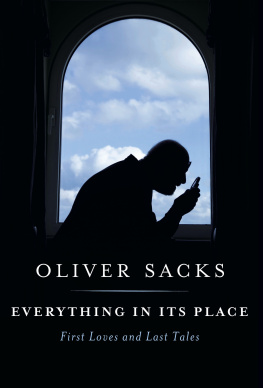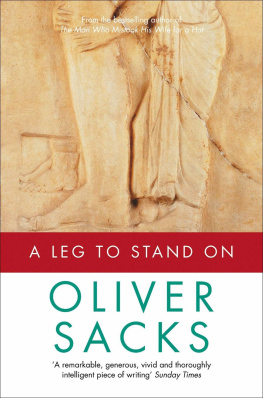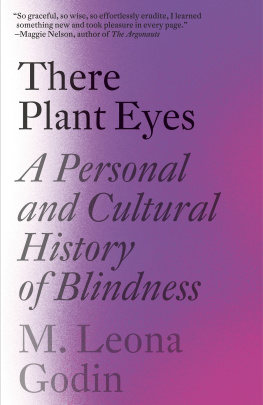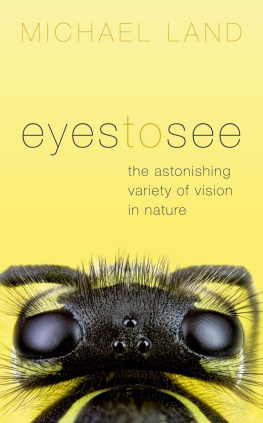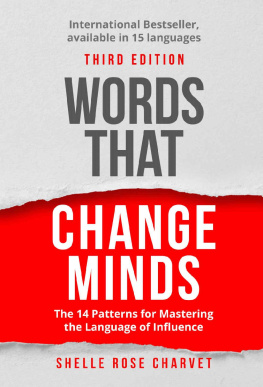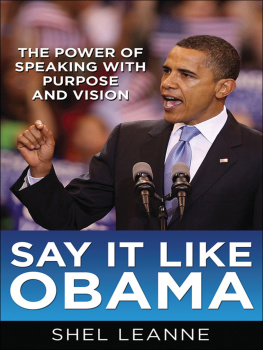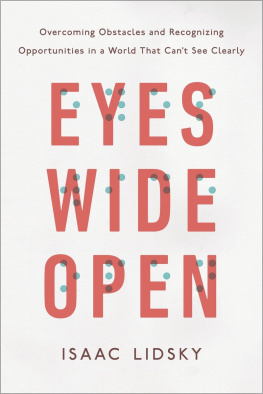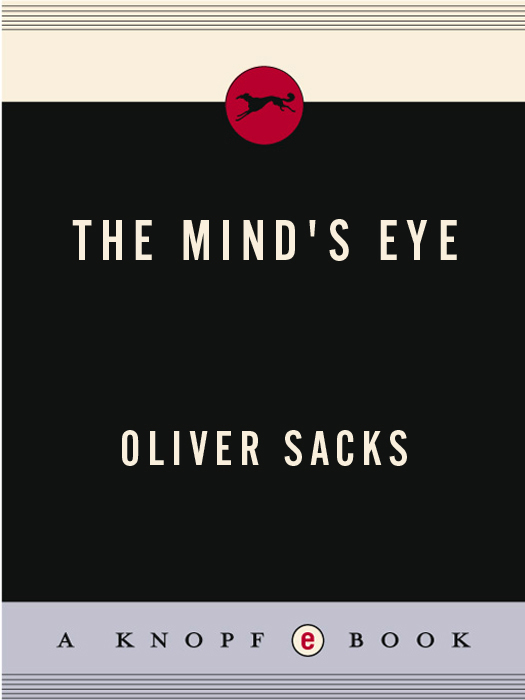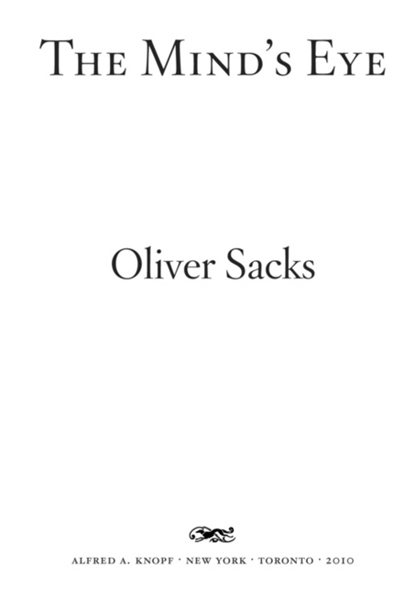ALSO BY OLIVER SACKS
Migraine
Awakenings
A Leg to Stand On
The Man Who Mistook His Wife for a Hat
Seeing Voices
An Anthropologist on Mars
The Island of the Colorblind
Uncle Tungsten
Oaxaca Journal
Musicophilia
THIS IS A BORZOI BOOK
PUBLISHED BY ALFRED A. KNOPF AND ALFRED A. KNOPF CANADA
Copyright 2010 by Oliver Sacks
All rights reserved. Published in the United States by Alfred A. Knopf, a division of Random House, Inc., New York, and in Canada by Alfred A. Knopf Canada, a division of Random House of Canada Limited, Toronto.
www.aaknopf.com
www.randomhouse.ca
Knopf, Borzoi Books, and the colophon are registered trademarks of Random House, Inc.
Knopf Canada and colophon are registered trademarks.
Portions of this work originally appeared in different form in The New Yorker.
Permission to quote previously published material may be found following the index.
Library of Congress Cataloging-in-Publication Data
Sacks, Oliver W.
The minds eye / Oliver Sacks.
p. cm.
This is a Borzoi book.
1. Communicative disordersPopular works. 2. Cognition disordersPopular works. 3. Face perceptionPopular works. 4. PerceptionPopular works. I. Title.
RC423.S23 2010
616.855dc22
2010012791
Library and Archives Canada Cataloguing in Publication
Sacks, Oliver W.
The minds eye / Oliver Sacks.
eISBN: 978-0-307-59455-6
1. Visual perception. 2. BlindnessPsychological aspects. I. Title.
BF241.S136 2010 152.14 C2010-901429-4
v3.1
for David Abramson
C ONTENTS

P REFACE
I grew up in a household full of doctors and medical talkmy father and older brothers were general practitioners, and my mother was a surgeon. A lot of the dinner-table conversation was inevitably about medicine, but the talk was never just about cases. A patient might present as a case of this or that, but in my parents conversation, cases became biographies, stories of peoples lives as they responded to illness or injury, stress or misfortune. Perhaps it was inevitable that I myself became both a physician and a storyteller.
When The Man Who Mistook His Wife for a Hat was published in 1985, it was given a very pleasant review by an eminent academic neurologist. The cases, he wrote, were fascinating, but he had one reservation: he thought I was being disingenuous in presenting patients as if I had come to them with no preconceptions, with little background knowledge of their conditions. Did I really read up on the scientific literature only after seeing a patient with a particular condition? Surely, he thought, I had started with a neurological theme in mind and simply sought out patients who exemplified it.
But I am not an academic neurologist, and the truth is that most practicing physicians have, apart from their broad medical education, little in-depth knowledge of many conditions, especially those which are considered rare, and thus not worthy of much time in medical school. When a patient presents himself with such a condition, we must do some research and, especially, go back to original descriptions. Typically, then, my case histories start with an encounter, a letter, a knock on the doorit is the patients description of their experience that stimulates the more general exploration.
As a general neurologist working mostly in old-age homes, I have seen thousands of patients over the past decades. All of them have taught me something, and I enjoy seeing themin some cases, we have been seeing each other regularly, as doctor and patient, for twenty years or more. In my clinical notes, I do my best to record what is happening with them and to reflect on their experiences. Occasionally, with the patients permission, my notes evolve into essays.
After I began publishing case histories, starting with Migraine in 1970, I began receiving letters from people seeking to understand or comment on their own neurological experiences, and such correspondence has become, in a way, an extension of my practice. Thus some of the people I describe in this book are patients; others are people who have written to me after reading one of my case histories. I am grateful to all of them for agreeing to share their experiences, for such experiences enlarge the imagination and show us what is often concealed in health: the complex workings of the brain and its astounding ability to adapt and overcome disabilityto say nothing of the courage and strength that individuals can show, and the inner resources they can bring to bear, in the face of neurological challenges that are almost impossible for the rest of us to imagine.
Many of my colleagues, past and present, have generously shared their time and expertise to discuss the ideas in this book or to comment on its various drafts. To all of them (and the many whom I have omitted here) I am most grateful, especially to Paul Bach-y-Rita, Jerome Bruner, Liam Burke, John Cisne, Jennifer and John Clay, Bevil Conway, Antonio and Hanna Damasio, Orrin Devinsky, Dominic ffytche, Elkhonon Goldberg, Jane Goodall, Temple Grandin, Richard Gregory, Charles Gross, Bill Hayes, Simon Hayhoe, David Hubel, Ellen Isler at the Jewish Braille Institute, Narinder Kapur, Christof Koch, Margaret Livingstone, Ved Mehta, Ken Nakayama, Grel Kristina Nslund, Alvaro Pascual-Leone, Dale Purves, V. S. Ramachandran, Paul Romano, Israel Rosenfield, Theresa Ruggiero, Leonard Shengold, Shinsuke Shimojo, Ralph Siegel, Connie Tomaino, Bob Wasserman, and Jeannette Wilkens.
I could not have completed this book without the moral and financial support of a number of institutions and individuals, and I am enormously indebted to them, above all to Susie and David Sainsbury, Columbia University, The New York Review of Books, The New Yorker, the Wylie Agency, the MacDowell Colony, Blue Mountain Center, and the Alfred P. Sloan Foundation. I am grateful, too, to the many people at Alfred A. Knopf, Picador UK, Vintage Books, and my other publishers around the world.
Several correspondents have contributed ideas or descriptions to this book, including Joseph Bennish, Joan C., Larry Eickstaedt, Anne F., Stephen Fox, J. T. Fraser, and Alexandra Lynch.
I am grateful to John Bennet at The New Yorker and Dan Frank at Knopf, superb editors who have improved this book in many ways; and to Allen Furbeck for his help with the illustrations. Hailey Wojcik typed many of the drafts and contributed research and virtually every other type of assistance, to say nothing of deciphering and transcribing the almost 90,000 words of my melanoma journals. Kate Edgar has, for the past twenty-five years, filled a unique role as collaborator, friend, editor, organizer, and much else. She has incited me, as always, to think and write, to see from different perspectives, but always to return to the center.
Above all, I am indebted to my subjects or patients and their families: Lari Abraham, Sue Barry, Lester C., Howard Engel, Claude and Pamela Frank, Arlene Gordon, Patricia and Dana Hodkin, John Hull, Lilian Kallir, Charles Scribner, Jr., Dennis Shulman, Sabriye Tenberken, and Zoltan Torey. They have not only allowed me to write about their experiences and quote their descriptions; they have commented on drafts, introduced me to other people and resources, and, in many cases, become good friends.


